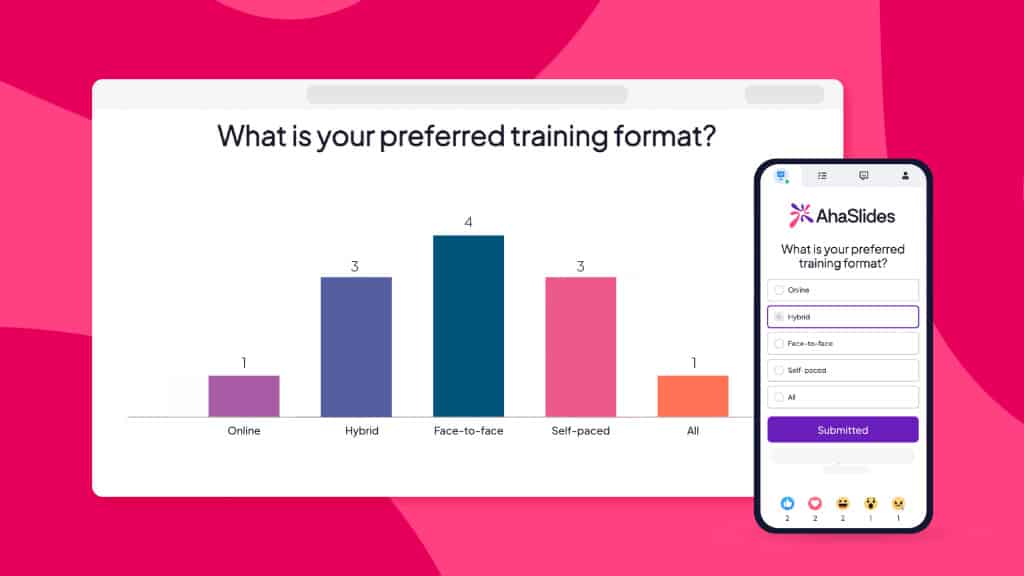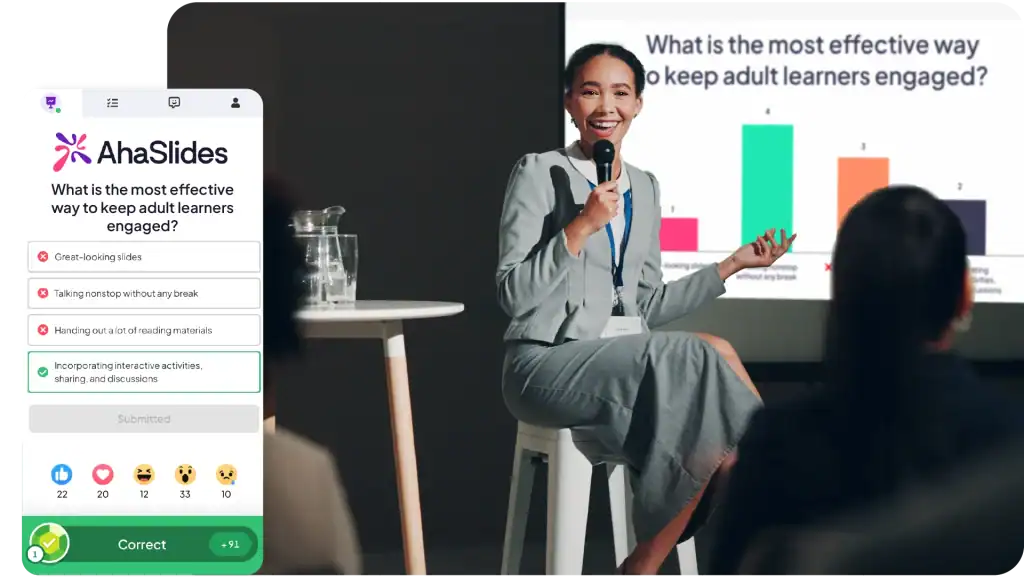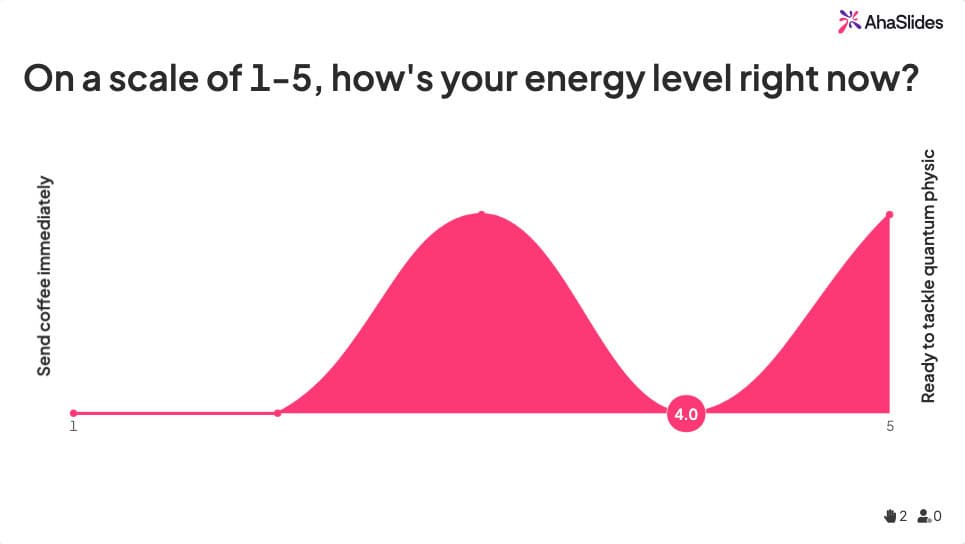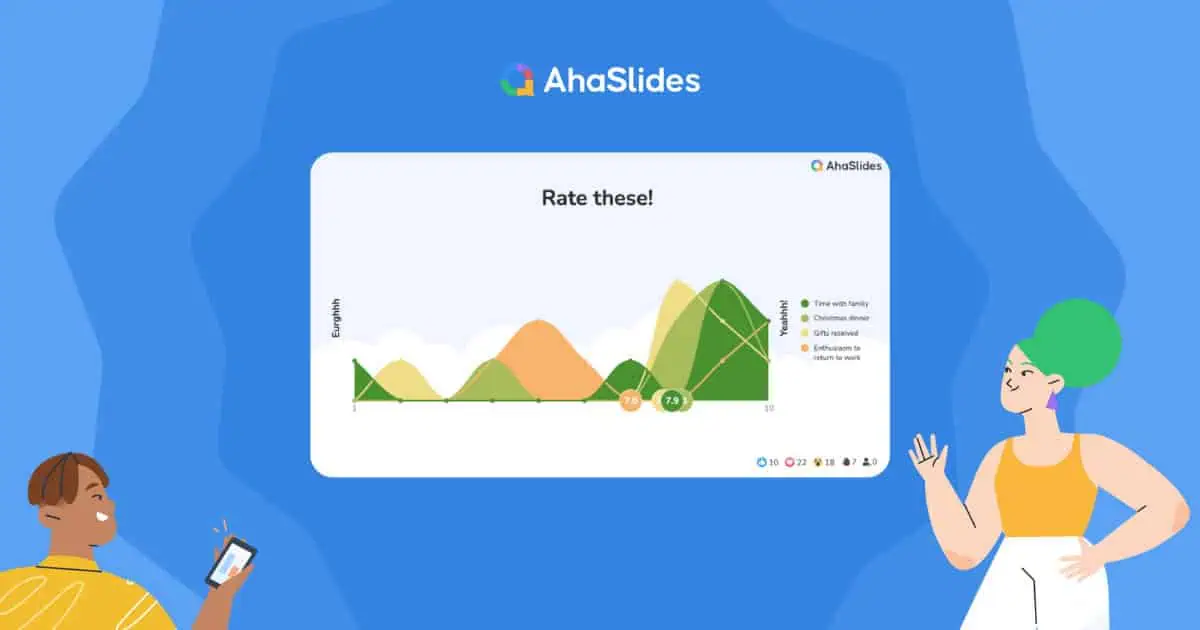У сённяшняй эканоміцы ўвагі, якая грунтуецца на TikTok, у вас ёсць каля 8 секунд, каб прыцягнуць увагу кагосьці — менш часу, чым у залатой рыбкі. Калі гэта гучыць складана для 5-хвіліннай прэзентацыі, вось добрая навіна: кароткія прэзентацыі — ваша сакрэтная зброя.
Пакуль іншыя праглядаюць 60 слайдаў, назіраючы, як іх вочы засцілаюць, вы данясеце мэтанакіраванае паведамленне, якое запамінаецца. Незалежна ад таго, ці выступаеце вы перад інвестарамі, навучаеце каманду, якая працуе дыстанцыйна, прадстаўляеце вынікі даследавання ці праходзіце сумоўе на пасаду мары, авалоданне 5-хвілінным фарматам не толькі зручна, але і вызначае вашу кар'еру.
Гэты дапаможнік абапіраецца на навуку прэзентацый, меркаванні прафесійных трэнераў, якія штогод праводзяць сотні заняткаў, і правераныя метады спікераў TED, каб дапамагчы вам ствараць прэзентацыі, якія прыцягваюць увагу, пераконваюць і пакідаюць працяглы ўплыў.
Змест
Чаму 5-хвілінныя прэзентацыі патрабуюць іншага падыходу
даследаванні Даследаванне нейрабіёлага Джона Медыны паказвае, што ўвага аўдыторыі значна падае кожныя 10 хвілін падчас традыцыйных прэзентацый. У віртуальных умовах гэта акно скарачаецца да ўсяго 4 хвілін. Ваша 5-хвілінная прэзентацыя ідэальна ўпісваецца ў гэты аптымальны прамежак часу — але толькі калі вы правільна яе распрацуеце.
Стаўкі вышэйшыя пры кароткіх прэзентацыях. Кожнае слова мае значэнне. Кожны слайд мае значэнне. Няма часу на пустыя словы, няма месца для адступленняў і няма цярпімасці да тэхнічных памылак. Даследаванні галіны паказваюць, што 67% спецыялістаў цяпер аддаюць перавагу лаканічным, мэтанакіраваным прэзентацыям перад доўгімі, але большасць дакладчыкаў усё яшчэ ставяцца да кароткіх дакладаў як да скарочаных версій доўгіх, што рэдка працуе.
Як зрабіць 5-хвілінную прэзентацыю
Крок 1: Выберыце тэму з хірургічнай дакладнасцю

Найбольшая памылка, якую робяць дакладчыкі? Яны спрабуюць ахапіць занадта шмат тэмы. Ваша 5-хвілінная прэзентацыя павінна ахопліваць адна асноўная ідэя— не тры, нават не два. Уявіце сабе гэта як лазер, а не пражэктар.
Ваша тэма павінна прайсці гэты чатырохчасткавы тэст:
- Адзіны каардынацыйны пункт: Ці можаце вы растлумачыць гэта адным сказам? Калі не, то ўдакладніце.
- Рэлевантнасць аўдыторыі: Ці вырашае гэта праблему, з якой яны актыўна сутыкаюцца? Прапускайце інфармацыю, якую яны ўжо ведаюць.
- Прастата: Ці можаце вы растлумачыць гэта без складанай перадумовы? Захавайце складаныя тэмы для больш працяглых фарматаў.
- Ваша экспертыза: Трымайцеся прадметаў, якія вы добра ведаеце. Час на падрыхтоўку абмежаваны.
Для натхнення разгледзьце гэтыя правераныя 5-хвілінныя тэмы ў розных кантэкстах:
- Прафесійныя налады: 3 стратэгіі, заснаваныя на дадзеных, для скарачэння адтоку кліентаў, Як інструменты штучнага інтэлекту змяняюць наш працоўны працэс, Чаму нашы вынікі за 3 квартал сігналізуюць аб стратэгічным павароце
- Навучанне і навучанне: Адна звычка, якая змяняе прадукцыйнасць дыстанцыйнай каманды, Псіхалогія, якая ляжыць у аснове паказчыкаў задаволенасці супрацоўнікаў, Як даваць зваротную сувязь, якая сапраўды паляпшае паводзіны
- Акадэмічныя кантэксты: Асноўныя высновы майго даследавання ўстойлівага развіцця, Як сацыяльныя сеткі ўплываюць на прыняцце рашэнняў падлеткамі, Этыка рэдагавання генаў у трох рэальных сцэнарыях
Крок 2: Стварыце слайды, якія дапаўняюць увагу (а не адцягваюць увагу)
Вось праўда, якая адрознівае аматараў-вядучых ад прафесійных: ты — прэзентацыя, а не твае слайды. Слайды павінны падтрымліваць ваш нарратыў, а не замяняць яго.
Пытанне пра колькасць слайдаў
Даследаванні экспертаў па прэзентацыях рэкамендуюць выкарыстоўваць 5-7 слайдаў для 5-хвіліннага выступу — прыкладна адзін слайд у хвіліну, у тым ліку час на ўступ і заключэнне. Аднак, выступоўцы на TED часам выкарыстоўваюць 20 слайдаў, якія хутка праглядаюць (па 10-15 секунд кожны), каб захаваць візуальны імпульс. Больш важныя за колькасць — гэта яснасць і мэта.
Прынцыпы дызайну кантэнту
- Мінімальны тэкст: Максімум 6 слоў на слайд. Ваш сцэнар аб'ёмам 700 слоў павінен быць прамоўлены, а не паказаны.
- Візуальная іерархія: Выкарыстоўвайце памер, колер і белую прастору, каб прыцягнуць увагу да таго, што найбольш важна.
- Візуалізацыя дадзеных: Адна пераканаўчая статыстыка або графік на слайд пераўзыходзіць усе абзацы тлумачэнняў.
- Паслядоўны дызайн: Аднолькавыя шрыфты, колеры і макеты падтрымліваюць прафесіяналізм.
Pro рада: Зрабіце сваю прэзентацыю інтэрактыўнай з дапамогай жывых апытанняў, функцый пытанняў і адказаў або кароткіх віктарын. Гэта пераўтворыць пасіўных гледачоў у актыўных удзельнікаў і значна палепшыць запамінанне інфармацыі. Інструменты, падобныя на AhaSlides дазваляюць лёгка ўбудоўваць гэтыя функцыі, нават у 5-хвілінныя фарматы.

Крок 3: Авалодайце таймінгам з ваеннай дакладнасцю
У 5-хвіліннай прэзентацыі кожная секунда мае сваю задачу. Няма буфера для бессэнсоўных разважанняў або выпраўлення памылак. Прафесійныя выступоўцы прытрымліваюцца гэтай праверанай часам структуры:
Правераная формула размеркавання часу
- 0:00-0:30 – Адкрыццё кручка: Прыцягніце ўвагу дзіўным фактам, правакацыйным пытаннем або захапляльнай гісторыяй. Прапусціце доўгія ўступы.
- 0:30-1:30 – Праблема: Вызначце, чаму ваша аўдыторыя павінна зацікавіць вас. Якую праблему вырашае ваша тэма?
- 1:30–4:30 — Ваша рашэнне/меркаванне: Гэта ваш асноўны кантэнт. Дайце 2-3 ключавыя пункты з пацвярджальнымі доказамі. Выключыце ўсё неістотнае.
- 4:30-5:00 – Заключэнне і заклік да дзеяння: Падкрэсліце сваё асноўнае паведамленне і дакладна скажыце аўдыторыі, што рабіць далей.
Карэкціроўка віртуальнай прэзентацыі
Прэзентуеце дыстанцыйна? Кожныя 4 хвіліны ўключыце ўдзельнікаў у гульню (паводле даследавання Медыны). Выкарыстоўвайце апытанні, пытайцеся ў чаце ці задавайце рытарычныя пытанні. Праверце ракурс камеры (узровень вачэй), пераканайцеся ў моцным асвятленні спераду і загадзя праверце якасць гуку. Віртуальная аўдыторыя больш схільная да адцягнення ўвагі, таму ўзаемадзеянне не з'яўляецца абавязковым — яно неабходнае.

Крок 4: Выконвайце заданне з сапраўднай упэўненасцю

Нават бліскучы кантэнт губляе сваю эфектыўнасць з-за дрэннай падачы. Вось як прафесіяналы падыходзяць да моманту ісціны:
Практыкуйцеся так, быццам ад гэтага залежыць ваша кар'ера (бо гэта магчыма).
Рэпеціруйце сваю 5-хвілінную прэзентацыю як мінімум 5-7 разоў. Выкарыстоўвайце таймер. Запішыце сябе і пераглядзіце — гэта балюча, але неацэнна. Трэніруйцеся, пакуль не зможаце натуральна прамаўляць свой кантэнт, не чытаючы слайды. Мышачная памяць дапамагае перажыць нервовасць.
Метады падачы, якія адрозніваюць аматараў ад прафесіяналаў
- Вакальная разнастайнасць: Змяняйце тэмп, вышыню і гучнасць. Рабіце стратэгічныя паўзы для падкрэслівання — цішыня мае вялікую сілу.
- Мова цела: Пры асабістай сустрэчы выкарыстоўвайце адкрытыя жэсты і рухайцеся мэтанакіравана. Перад камерай абмяжуйце жэсты (яны ўзмацняюць іх) і падтрымлівайце глядзельны кантакт з аб'ектывам.
- апавяданне: Уключыце кароткі, адпаведны прыклад або анекдот. Гісторыі паляпшаюць запамінанне ў 22 разы ў параўнанні з адны толькі факты.
- Кіраванне энергіяй: Падбярыце сваю энергію да паслання. Захапляйцеся натхненнем, але абмяркоўвайце сур'ёзныя тэмы.
- Тэхнічная гатоўнасць: Праверце абсталяванне на 30 хвілін раней. Майце запасныя планы на выпадак праблем з падключэннем.
Сакрэт сувязі з аўдыторыяй
Уявіце сабе прэзентацыю як размову, а не выступ. Падтрымлівайце глядзельны кантакт (альбо глядзіце ў камеру падчас віртуальных прэзентацый). Звяртайце ўвагу на рэакцыю. Калі вы памыляецеся, зрабіце кароткую паўзу і працягвайце — аўдыторыя даруе аўтэнтычнасць, але не рабатызаванае чытанне слайдаў.
Сакрэтны савет: Не ведаеце, ці зробіць ваша 5-хвілінная прэзентацыя ўражанне? Выкарыстоўвайце інструмент зваротнай сувязі каб адразу сабраць настроі аўдыторыі. Гэта патрабуе мінімальных намаганняў, і вы пазбегнеце страты каштоўнай зваротнай сувязі на гэтым шляху.

5 распаўсюджаных памылак пры правядзенні 5-хвіліннай прэзентацыі
Мы пераадольваем і адаптуемся метадам спроб і памылак, але прасцей пазбегнуць памылак пачаткоўцаў, калі вы ведаеце, што гэта такое👇
- З цягам часу: Публіка заўважае. Гэта сведчыць пра дрэнную падрыхтоўку і парушае іх графік. Трэніруйцеся, каб скончыць а 4:45.
- Перагрузка слайдаў: Слайды з вялікай колькасцю тэксту прымушаюць аўдыторыю чытаць, а не слухаць. Вы імгненна губляеце іх увагу.
- Практыкаванні са скачкамі: «Гэта ўсяго 5 хвілін» — небяспечная думка. Кароткія фарматы патрабуюць БОЛЬШ практыкі, а не менш.
- Стараюся ахапіць усё: Глыбіня перамагае шырыню. Адно выразнае меркаванне, якое рэзаніруе, лепш за пяць пунктаў, якія ніхто не памятае.
- Ігнараванне вашай аўдыторыі: Адаптуйце кантэнт да іх інтарэсаў, узроўню ведаў і патрэб. Абыкновенныя прэзентацыі ніколі не будуць папулярнымі.
Прыклады 5-хвілінных прэзентацый
Вывучыце гэтыя прыклады, каб убачыць прынцыпы ў дзеянні:
Уільям Камквамба: «Як я выручыў вецер»
Гэта TED Talk відэа прадстаўляе гісторыю Уільяма Камквамбы, вынаходніка з Малаві, які, будучы дзіцем, які перажываў беднасць, пабудаваў вятрак, каб перапампоўваць ваду і выпрацоўваць электрычнасць для сваёй вёскі. Натуральнае і прамалінейнае апавяданне Камквамбы змагло захапіць аўдыторыю, а выкарыстанне ім кароткіх паўз, каб людзі пасмяяліся, таксама з'яўляецца яшчэ адным цудоўным прыёмам.
Сьюзан В. Фіск: «Важнасць быць лаканічным»
Гэта навучалае відэа прапануе навукоўцам карысныя парады, каб пабудаваць сваю размову ў адпаведнасці з фарматам прэзентацыі «5 Minute Rapid», які таксама тлумачыцца за 5 хвілін. Калі вы плануеце стварыць кароткую прэзентацыю «Як зрабіць», паглядзіце гэты прыклад.
Джонатан Бэл: "Як стварыць выдатны брэнд"
Як вынікае з назвы, дакладчык Джонатан Бэл дасць вам крок за крокам кіраўніцтва аб тым, як стварыць устойлівы брэнд. Ён адразу пераходзіць да сутнасці сваёй тэмы, а затым разбівае яе на больш дробныя кампаненты. Добры прыклад, на якім можна вучыцца.
Рахунак PACE: «5-хвілінны пітч на Startupbootcamp»
Гэта відэа паказвае, як Рахунак-фактура PACE, стартап, які спецыялізуецца на апрацоўцы плацяжоў у некалькіх валютах, змог выразна і сцісла выкласці свае ідэі інвестарам.
Уіл Стывен: «Як прагучаць разумна ў сваім выступленні на TEDx»
Выкарыстоўваючы гумарыстычны і творчы падыход, Ці будзе выступ Стывена на TEDx вядзе людзей праз агульныя навыкі публічнага выступлення. Абавязковы прагляд, каб ператварыць вашу прэзентацыю ў шэдэўр.
Гатовыя ствараць прэзентацыі, якія сапраўды прыцягваюць увагу? Пачніце з інтэрактыўных інструментаў для прэзентацый AhaSlides і ператварыце сваю наступную 5-хвілінную прэзентацыю з лёгкай у незабыўную.








